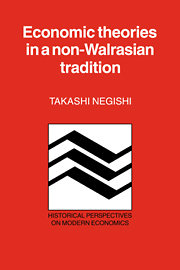Book contents
- Frontmatter
- Contents
- Preface
- 1 Anti-neoclassical or non-Walrasian economic theories
- Part I Increasing returns and diminishing cost
- 2 Adam Smith and increasing returns in a competitive situation
- 3 A reconstruction of Smith's doctrine on the natural order of investment
- 4 The possibility of a falling rate of profit under diminishing cost
- 5 Rehabilitation of Marshall's life-cycle theory to explain diminishing cost
- Part II Wages and profit
- Part III International trade and investment
- Part IV Markets and money
- Notes
- References
- Author index
- Subject index
5 - Rehabilitation of Marshall's life-cycle theory to explain diminishing cost
from Part I - Increasing returns and diminishing cost
Published online by Cambridge University Press: 21 September 2009
- Frontmatter
- Contents
- Preface
- 1 Anti-neoclassical or non-Walrasian economic theories
- Part I Increasing returns and diminishing cost
- 2 Adam Smith and increasing returns in a competitive situation
- 3 A reconstruction of Smith's doctrine on the natural order of investment
- 4 The possibility of a falling rate of profit under diminishing cost
- 5 Rehabilitation of Marshall's life-cycle theory to explain diminishing cost
- Part II Wages and profit
- Part III International trade and investment
- Part IV Markets and money
- Notes
- References
- Author index
- Subject index
Summary
Marshall offered several different solutions for the compatibility of increasing returns or diminishing cost and competitive equilibrium (see Robertson 1930 and Hague 1958).
Individual firms face a downward sloping demand curve even in a competitive market, unless the market is ideally organized like a Walrasian one.
When we are considering an individual producer, we must couple his supply curve – not with the general demand curve for his commodity in a wide market, but – with the particular demand curve of his own special market. And this particular demand curve will generally be very steep; perhaps as steep as his own supply curve is likely to be, even when an increased output will give him an important increase of internal economies.
(Marshall 1961, p. 458. See also Marshall 1961, pp. 457 and 459 and Chapter 14 of this book.)In this sense, it is also possible to argue that Marshall was a pioneer of modern theory of imperfect competition after Sraffa.
- Type
- Chapter
- Information
- Economic Theories in a Non-Walrasian Tradition , pp. 45 - 56Publisher: Cambridge University PressPrint publication year: 1985

